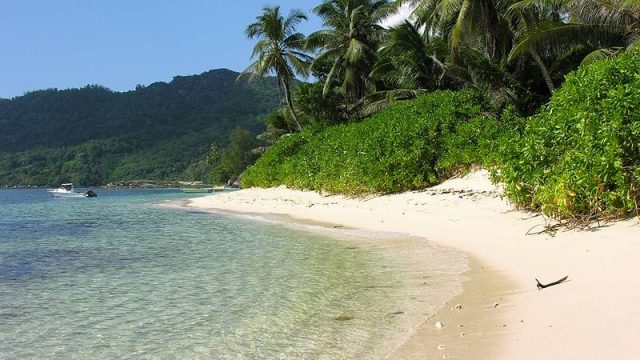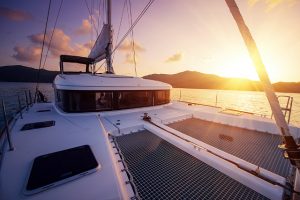With clear, coral fringed waters and a lush mountainous backdrop, the Seychelles is the perfect place for a honeymoon or lazy beach vacation; but it’s not all about cocktails at sunset and moonlight strolls on the beach. There’s plenty going on both above and below water to keep adrenaline-seekers happy too. Those seeking an energetic trip could try the following adventures in the Seychelles.
Diving
The Seychelles’ reefs, underwater canyons, wrecks and drop offs are buzzing with both fish and coral life, offering plenty to see for both experienced divers and newbies. Even shallow reefs close to shore hide a myriad of beauties: butterfly fish, angelfish and soldier fish are all common, and you may well spot octopus and lobster. Head a little further out and you’ll be rewarded with reef sharks, giant grouper, stingrays and turtles; at the more remote islands you could see nurse sharks, manta rays and the odd hammerhead.
Visibility is best from March to May, and in October-November. If you’re keen to see whale sharks, July and August are the best time to visit, when plankton in the water brings them closer to land.
Most dives take place on the Inner Islands, in particular around Mahé, Praslin and La Digue – the Seychelles’ tourist hub. Dive centres in the Seychelles for the most part offer modern dive equipment rental and it’s a great place to complete a PADI course. Good operators include Blue Sea Divers on Mahé, or Octopus Diver on Praslin, both of which offer courses as well as trips for experienced divers.
Hiking
The tourist hotspots of Mahé, La Digue and Praslin all have excellent trails into the hinterland. Most of the hikes are well signposted and can be attempted without much more than a sturdy pair of shoes and some water, but guided tours are also popular if you want to learn about the islands’ plant and animal life along the way.
Mahé’s 3050-hectare Morne Seychellois National Park offers a number of options for keen trekkers including a walk to the top of Morne Blanc. You’ll pass through an old tea plantation and misty forests (spotting many of the Seychelles’ native birds along the way) to reach the 905-meter-high summit, the highest point in the country. From here you’ll be rewarded with beautiful views across Mahé and over the ocean.
The Vallée de Mai, on Praslin, is one of two UNESCO World Heritage Sites in Seychelles, and a great place for more gentle walks. Here a number of paths crisscross an otherworldly natural palm forest of some 6,000 trees, which remains as it was many thousand of years ago.
Another option is a short walk up to Mahé’s Mission Lodge for the Seychelles’ most famous views, southwards past mountains and boulders and out to sea.
Rock climbing
Rock climbing and tropical paradise may not seem to go hand-in-hand, but the sport has become more and more popular on the islands because of its magnificent granite rock faces. There are plenty of challenging locations for experienced climbers, but beginners and children can try the Constance Ephélia Resort at Port Launay, where you can be guided over an 18-meter-high natural granite climbing wall (there is also a section for more experienced climbers to get stuck in to). Also at Port Launay you can fly through the forest canopy on a zip wire up to 120 meters in length.
Fishing
If you want to pose with a big fish these islands are the place to do it. The Seychelles offers some of the best big game and fly-fishing in the world, and you’ll come across dorado, tuna, marlin, shark, and grouper, among many others.
The best place for big game fishing is the edge of the Seychelles Bank, near Bird and Denis islands, where the ocean floor reaches depths of 1,800 meters. The outer island of Alphonse is good for fly fishers. Numbers of bonefish are so high that even beginners can catch a significant haul.
A tag-and-release policy is widely respected, and fly fishers can only use barbless hooks. There are also a number of protected areas where fishing is prohibited. The season runs from September to June.
Sailing
With most islands lying outside the cyclone belt, sailing around the Seychelles’ Inner Islands offers calm waters and miles of scenic coastline peppered with secret coves and safe anchorages.
The Outer Islands, such as the Amirantes and Alphonse, present a greater challenge: longer sailing distances and few, if any, amenities, but you’re more likely to get a stunning piece of coastline all to yourself.
Access to ecologically sensitive marine parks and reserve areas such as Sihouette and Ste. Anne is managed by various conservation organizations. To stay you’ll need advance permission and/or payment of entry and mooring fees. More information is available from the Seychelles National Parks Authority.
Mountain biking
Biking in the Seychelles is surprisingly diverse, and in a few hours you can pass through thick jungle, along windswept coastal roads, and up and down tough mountain trails. Since over 50% of the Seychelles is made up of nature reserves there’s plenty of opportunity to get off road, but be prepared for the fact that a lot of trails are poorly maintained. You’ll find the most facilities on the three main islands of Mahé, Praslin and La Digue.
The trail up Mahé’s Morne Blanc is one of the islands’ best. It’s a difficult 900-meter climb, but you’ll be rewarded by an outstanding view over the ocean and out to surrounding islands.
Wildlife spotting
The Seychelles is also home to some amazing wildlife. Tortoise fans can go to Curieuse Island, home to the Curieuse Marine National Park – essentially a giant open-air zoo where massive Seychellois tortoises, which weigh 300-600 pounds, roam freely through the park’s coco-de-mer trees. The rare sooty tern and Seychelles white-eye birds can be seen here too, and from September to March hawksbill turtles make their nests along the sandy coastline.
The world’s largest tortoise – the 650-pound, 200-year-old Esmerelda – lives on Bird Island, a successful wildlife reserve, which is also home almost a million breeding pairs of sooty terns. The endemic Seychelles black parrot can be found in the Vallée de Mai Nature Reserve.
More from AFKTravel:
The Intimate Inns Of Seychelles
Which Seychelles Island Is For You?
Dreamy Private Islands In Seychelles You Can Have All To Yourself





